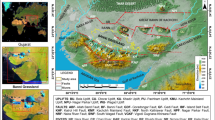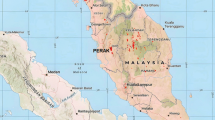Abstract
The draining of mires for silvicultural purposes has caused one of the most dramatic changes in the landscape during the last century in Finland. To study the effects of mire drainage, carabid beetle assemblages were sampled using pitfall trapping in three different mire habitat types. Carabids were sampled from mires in their natural state, drained mires and drained mires with an open power line to see whether the cleared power line can serve as an alternative habitat for mire dependent carabids. The draining of mires greatly increases the species richness of the carabid assemblages. Yet, the conservation value of the environment has dropped following the draining, since only common and abundant forest carabids have benefited from human impact. The role of the open power line as an alternative habitat for mire specialists remains questionable. A few carabid species have, however, benefited from the open habitat of the power line. The vegetation structure had a significant effect in determining the compositions of the carabid assemblages on the studied habitat types. It seems that mire dwelling carabids cannot survive on the drained mires, unless at least some characteristics, other than the mere openness of the cleared power lines, of natural mires remain.


Similar content being viewed by others
References
Abildsnes J, Tømmerås BÅ (2000) Impacts of experimental habitat fragmentation on ground beetles (Coleoptera, Carabidae) in a boreal spruce forest. Ann Zool Fenn 37:201–212
Ahti T, Hämet-Ahti L, Jalas J (1968) Vegetation zones and their section in Nothwestern Europe. Ann Bot Fenn 5:169–211
Andersen AN (1999) My bioindicator or yours? Making the selection. J Insect Conserv 3:61–64
Angus RB, Brown RE, Bryant LJ (2000) Chromosomes and identification of the sibling species Pterostichus nigrita (Paykull) and P. rhaeticus Heer (Coleoptera: Carabidae). Syst Entomol 25:325–337
Assmann T, Janssen J (1999) The effects of habitat changes on the endangered ground beetle Carabus nitens (Coleoptera: Carabidae). J Insect Conserv 3:107–116
Atlegrim O, Sjöberg K, Ball JP (1997) Forestry effects on a boreal ground beetle community in spring: selective logging and clear-cutting compared. Entomol Fennica 8:19–27
Ausden M, Treweek J (1995) Grasslands. In: Sutherland WJ, Hill DA (eds) Managing habitats for conservation. Cambridge University Press, Cambridge
Baars MA (1979) Catches in pitfall traps in relation to mean densities of Carabid beetles. Oecologia 41:25–46
Barber HS (1931) Traps for cave-inhabiting insects. Journal of the Elisha Mitchell Scientific Society 46:259–266
Butterfield J, Coulson JC (1983) The carabid communities on peat and upland grasslands in northern England. Holarct Ecol 6:163–174
Davies KF, Margules CR (1998) Effects of habitat fragmentation on carabid beetles: experimental evidence. J Anim Ecol 67:460–471
de Vries HH, den Boer PJ (1990) Survival of populations of Agonum ericeti Panz (Col, Carabidae) in relation to fragmentation of habitats. Neth J Zool 40:484–498
Eurola S, Aapala K, Kokko A, Nironen M (1991) Mire type statistics in the bog and southern aapa mire areas of Finland (60–66°N). Ann Bot Fennici 28:15–36
Eyre MD, Rushton SP (1989) Quantification of conservation criteria using invertebrates. J Appl Ecol 26:159–173
Eyre MD, Lott DA, Garside A (1996) Assessing the potential for environmental monitoring using ground beetles (Coleoptera: Carabidae) with riverside and Scottish data. Ann Zool Fenn 33:157–163
Främbs H (1990) Changes in Carabid beetle populations on a regenerating excavated peat bog in Northwest Germany. In: Stork NE (ed) The role of ground beetles in ecological and environmental studies. Athenaeum Press, Newcastle upon Tyne
Garson J, Aggarwal A, Sarkar S (2002) Birds as surrogates for biodiversity: an analysis of a data set from southern Quebec. J Biosci 27:347–360
Geiger R (1965) The climate near the ground. Harward University Press, Massachusetts
Greenslade PJM (1964) Pitfall trapping as a method for studying populations of Carabidae (Coleoptera). J Anim Ecol 33:301–310
Halme E, Niemelä J (1993) Carabid beetles in fragments of coniferous forest. Ann Zool Fenn 30:17–30
Hanski K, Ovaskainen O (2003) Metapopulation theory for fragmented landscapes. Theor Popul Biol 64:119–127
Hertz M (1927) Huomioita petokuoriaisten olinpaikoista (in Finnish). Luonnon Ystävä 31:218–222
Holmes PR, Fowles AP, Boyce DC, Reed DK (1993) The ground beetle (Coleoptera: Carabidae) fauna of Welsh peatland biotopes-species assemblages in relation to peatland habitats and management. Biol Conserv 65:61–67
Horn HS (1966) Measurement of “overlap” in comparative ecological studies. Am Nat 100:419–424
Jackson DA (1995) Protest—a Procrustean randomization test of community environment concordance. Ecoscience 2:297–303
Kalliola R (1973) Suomen Kasvimaantiede (in Finnish). WSOY, Porvoo
Kapos V (1989) Effects of isolation on the water status of forest patches in the Brazilian Amazon. J Trop Ecol 5:173–185
Koivula M, Kukkonen J, Niemelä J (2002) Boreal carabid-beetle (Coleoptera, Carabidae) assemblages along the clear-cut originated succesion gradient. Biodivers Conserv 11:1269–1288
Koivula M, Kotze DJ, Hiisivuori L et al (2003) Pitfall trap efficiency: do trap size, collecting fluid and vegetation structure matter? Entomol Fennica 14:1–14
Krebs CJ (1999) Ecological methodology. Benjamin/Cummings, Menlo Park California
Kuussaari M, Ryttäri T, Heikkinen R et al (2003) Significance of power line areas for grassland plants and butterflies (in Finnish with English summary). The Finnish Environment 638:1–66
Lappalainen E (1996) General review on world peatland and peat resources. In: Lappalainen E (ed) Global peat resources. International Peat Society, Jyskä
Lindroth CH (1985) The Carabidae (Coleoptera) of Fennoscandia and Denmark Fauna Entomologica Scandinavica 15, part 1. Scandinavian Science Press Ltd., Leiden
Lindroth CH (1986) The Carabidae (Coleoptera) of Fennoscandia and Denmark Fauna Entomologica Scandinavica 15, part 2. Scandinavian Science Press Ltd, Leiden
Luff ML (1975) Some features influencing the efficiency of pitfall traps. Oecologia 19:345–357
Luff ML (1996) Use of Carabids as environmental indicators in grasslands and cereals. Ann Zool Fenn 33:185–195
Luff ML, Eyre MD, Rushton SP (1992) Classification and prediction of grassland habitats using ground beetles (Coleoptera, Carabidae). J Environ Manage 35:301–315
Lövei GL, Sunderland KD (1996) Ecology and behaviour of ground beetles (Coleoptera, Carabidae). Annu Rev Entomol 41:231–256
Matlack GR (1993) Microenvironment variation within and among forest edge sites in the eastern United States. Biol Conserv 66:185–194
Mikkola K, Jalas I, Peltonen O (1985) Suomen perhoset: Mittarit I (in Finnish). Suomen Perhostutkijain Seura, Tampere
Minchin PR (1987) An evaluation of the relative robustness of techniques for ecological ordination. Vegetatio 69:89–107
Murcia C (1995) Edge effects in fragmented forests: implications for conservation. Trends Ecol Evol 10:58–62
Nakagawa S (2004) A farewell to Bonferroni: the problems of low statistical power and publication bias. Behav Ecol 15:1044–1045
Niemelä J (2000) Biodiversity monitoring for decision-making. Ann Zool Fenn 37:307–317
Niemelä J (2001) Carabid beetles (Coleoptera: Carabidae) and habitat fragmentation: a review. Eur J Entomol 98:127–132
Niemelä J, Haila Y, Halme E et al (1988) The distribution of carabid beetles in fragments of old coniferous taiga and adjacent managed forest. Ann Zool Fenn 25:107–119
Noss RF (1990) Indicators for monitoring biodiversity: a hierarchial approach. Conserv Biol 4:355–364
Nuutinen T, Hirvelä H, Hynynen J et al (2000) The role of peatlands in finnish wood production—an analysis based on large-scale forest scenario modelling. Silva Fenn 34:130–153
Peres-Neto PR, Jackson DA (2001) How well do multivariate data sets match? The advantages of a Procrustean superimposition approach over the Mantel test. Oecologia 129:169–178
Prendergast JR, Quinn RM, Lawton JH et al (1993) Rare species, the coincidence of diversity hotspots and conservation strategies. Nature 365:335–337
Quinn GP, Keough MJ (2002) Experimental design and data analysis for biologists. Cambridge University Press, Cambridge
Rainio J, Niemelä J (2003) Ground beetles (Coleoptera: Carabidae) as bioindicators. Biodivers Conserv 12:487–506
Rassi P (ed) (1993) Suomen kovakuoriaisten (Coleoptera) frekvenssipisteet 1.1.1960–1.1.1990 (in Finnish). Viestipaino Oy, Helsinki
Rassi P, Alanen A, Kanerva T et al (2001) Suomen lajien uhanalaisuus 2000 (in Finnish). Ympäristöministeriö & Suomen ympäristökeskus, Helsinki
Rykken JJ, Capen DE, Mahabir SP (1997) Ground beetles as indicators of land type diversity in the Green Mountains of Vermont. Conserv Biol 11:522–530
Salminen P (1983) Soiden suojelu. In: Ruuhijärvi R, Häyrinen U (eds) Ympäristönsuojelu 2 (in Finnish). Kirjayhtymä, Helsinki
Saunders DA, Hobbs RJ, Margules CR (1991) Biological consequenses of ecosystem fragmentation: a review. Conserv Biol 5:18–32
Silfverberg H (2004) Enumeratio nova Coleopterorum Fennoscandiae, Daniae et Baltiae. Sahlbergia 9:1–111
Spence JR, Niemelä JK (1994) Sampling Carabid assemblages with pitfall traps: the madness and the method. Can Entomol 126:881–894
Spitzer K, Bezdík A, Jaroš J (1999) Ecological succession of a relict Central European peat bog and variability of its insect biodiversity. J Insect Conserv 3:97–106
Thiele H-U (1977) Carabid beetles in their environments. Springer-Verlag, Berlin/Heiderberg
Williams P, Gibbons D, Margules C et al (1996) A comparison of richness hotspots, rarity hotspots and complementary areas for conserving diversity of British birds. Conserv Biol 10:155–174
Acknowledgements
We thank Riikka Nevalainen and Mikko Pentinsaari for their contribution to collecting of data on plants and beetles and for valuable comments on the earlier draft of the manuscript. We are indebted to Ari Levula for assistance and Fingrid Oyj for financial support.
Author information
Authors and Affiliations
Corresponding author
Rights and permissions
About this article
Cite this article
Hollmen, A., Välimäki, P., Itämies, J. et al. The value of open power line habitat in conservation of ground beetles (Coleoptera: Carabidae) associated with mires. J Insect Conserv 12, 163–177 (2008). https://doi.org/10.1007/s10841-007-9076-7
Received:
Accepted:
Published:
Issue Date:
DOI: https://doi.org/10.1007/s10841-007-9076-7




